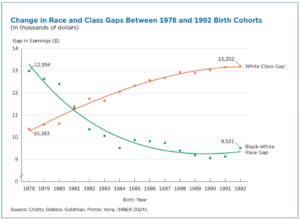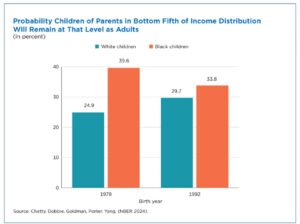Earnings gap shrinks for poor Blacks while class differences expand for poor whites

The U.S. Census Bureau and Harvard University researchers released a report in late July that indicates that while the low-income earnings gap between Blacks and whites has narrowed, the gap between low-income and high-income young white adults has widened.
What the heck does this mean? What’s the bottom line? Well, it appears that young Blacks are making some economic progress — even though the gap between Blacks and whites is still too wide — while on the other hand, young whites from low-income families appear to be faring much worse than they did in previous generations. The study’s findings are insightful.
To begin with, the analysis focused on the evolution of income mobility between only two generations that were about 15 years apart. The first group included children born in 1978 and the second group looked at those born in 1992. The study considered the income levels of the two groups at the age of 27. And it included children born to both low-income parents (about $26,000 annual income) and high-income parents (about $95,000 annual income).
The findings revealed that Black children born to low-income parents in 1978 went on to earn $12,994 less per year than their white counterparts. However, for Black children born to low-income parents in 1992, the earnings gap shrunk by nearly a third, to $9,521.
On the other hand, white children who were born to high-income parents in the 1978 cohort went on to earn $10,383 more than low-income whites born that year. For those born in 1992, the class gap among whites rose to $13,202, an increase of nearly a third.
The report credited the shrinking race gap between Black and white low-income earners to a combination of “improved mobility” for low-income Black children and “declines in earnings” for low-income white children.
The growing class gap was credited to both declining mobility for white children from low-income households and improvements in mobility of white children from high-income households.
There was hardly any noticeable change in the class gap for Black children during the study periods because Black children — whether they are born to high- or low-income parents — saw comparable improvements in their earnings.
Earnings were not the only area where the gaps closed between Blacks and whites. According to the report, similar patterns of shrinking race gaps and growing class gaps were also noted in other areas. Included among them were shrinking gaps in educational attainment, standardized test scores, marriage rates and mortality.
For those of us in the Black community who continue to look for evidence of tangible progress toward equity in this country, this report noted that “the likelihood of growing up in a low-income household and remaining low-income as an adult actually narrowed by nearly 75% between Black and white children born in 1978 and 1992.”
The narrowing gap is attributed to the combination of a 6% decrease in poverty persistence among Black children and a 5% increase in poverty persistence among white children.
This study also looks at trends by county. While Black-white race gaps shrank and white class gaps expanded in nearly every part of the country, the magnitude of these changes varied substantially across regions.
The change in household income among Blacks in San Bernardino County, California, between 1978 and 1992 cohorts was an increase of 4.3%. For Riverside County the increase was far less, at 0.9%.
Finally, the research found there were few earnings changes among other racial and ethnic groups during the periods included in the report.
Although this data is indicative of some progress, the quest for economic equity persists. As a result, the struggle for economic justice continues.
This story was originally published at Black Voices News.








